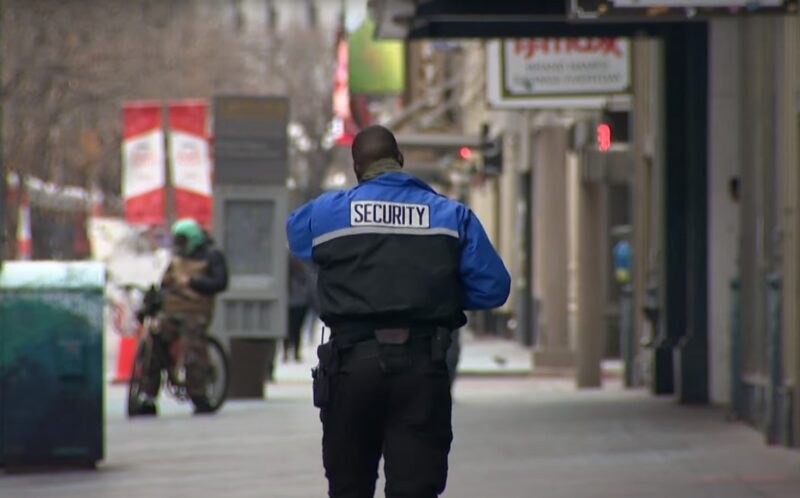Denver, spanning a vast 155 square miles with a population of about 712,000 within its city limits and nearly 3 million in the wider metropolitan area, stands as a sprawling urban center in the heart of the Rocky Mountains.
This expansive city, with its mix of urban sophistication and outdoor adventure, attracts a diverse array of residents and visitors alike. Safety in Denver, as in any large city, varies by area and requires a mindful approach to navigate its streets and neighborhoods.
In this post, I will examine the latest crime statistics in Denver and offer useful tips for staying safe.
Key Takeaways
Crime Statistics

Here’s a summary of what I found doing research according to Neighborhoodscout,[1] including my interpretation of the data:
Denver’s safety ranks lower than 1% of U.S. neighborhoods, with a total crime index of 1, where 100 represents the safest areas. Annually, Denver experiences a total of 52,881 crimes, which breaks down into 7,545 violent crimes and 45,336 property crimes. This results in a crime rate of 74.14 per 1,000 residents, with violent crimes at 10.58 per 1,000 residents and property crimes at 63.56 per 1,000 residents.
The likelihood of becoming a victim of a violent crime in Denver is 1 in 95, significantly higher than Colorado’s average of 1 in 203. The violent crime rate in Denver is more than double the national median. Similarly, the chance of experiencing a property crime in Denver is 1 in 16, far exceeding the state average of 1 in 32 and the national median.
Denver’s crimes per square mile stand at 342, vastly surpassing the national median of 27.0, highlighting the city’s struggle with crime density.
Violent Crimes in Denver
| Crime Type | Number of Incidents | Rate per 1,000 Residents |
|---|---|---|
| Murder | 90 | 0.13 |
| Rape | 756 | 1.06 |
| Robbery | 1,301 | 1.82 |
| Assault | 5,398 | 7.57 |
Property Crimes in Denver
| Crime Type | Number of Incidents | Rate per 1,000 Residents |
|---|---|---|
| Burglary | 5,171 | 7.25 |
| Theft | 24,964 | 35.00 |
| Motor Vehicle Theft | 15,201 | 21.31 |
Possible Crime Reduction
Looking back at 2023, I can see clear signs that crime is returning to pre-pandemic levels, both nationally and here in Denver. Recently released FBI data[2] shows major declines across the country in violent and property crimes, and I’m pleased to say that Denver was part of this encouraging trend.
In 2023, we saw decreases in both violent and property crimes — including murder, aggravated assault, sexual assault, auto theft, robbery, and burglary — compared to 2022. Some of these declines were steep, like the number of stolen cars, which dropped 19%, resulting in nearly 2,870 fewer auto thefts.
There was a reduction of nearly 245 reported violent crime incidents in 2023, driven in part by a 7% reduction in non-fatal shooting incidents and a 5% reduction in homicides.
These reductions didn’t happen by chance. The women and men of the Denver Police Department (DPD) and the District Attorney’s office worked tirelessly, and in partnership, every single day to help bring them about.
Here are some of their achievements in 2023:
• Reduced our average response time for emergency calls by 10 seconds from when the 911 call was placed to a DPD officer arriving on the scene.
• The dedicated DPD auto theft team made 201 auto theft arrests and 45 additional felony arrests for other crimes.
• Officers removed more than 2,235 illegal firearms from the city’s streets.
• Continued our proactive enforcement and outreach efforts in crime hotspots, like the Westwood neighborhood, which didn’t have a single shooting the entire year.
• Created community homicide review events to propose and implement solutions to reduce violence.
• Established more specific guidelines for prosecuting motor vehicle theft and the sale of fentanyl.
• Expanded our Organized Crime Unit by adding two attorneys and two investigators, charging 23 people with aggravated motor vehicle theft, robbery, and burglary.
• Secured more than 70 guns from domestic violence offenders as part of our Firearms Relinquishment Program.
• Filed more than 7,900 misdemeanor cases and more than 5,600 felony cases, successfully prosecuting 51 murder cases.
• Argued and won a case in the Colorado Supreme Court upholding digital evidence search warrants in the Green Valley Ranch arson/homicide case.
• Helped establish a new competency court to better address defendants with mental health issues.
• Expanded our Restorative Justice Program, which has had a 2% recidivism rate among its participants since its inception in 2019.
5 Most Riskiest Parts Of Denver

| Neighborhood | Population | Crime Rate (% above national average) |
|---|---|---|
| Five Points | 8,199 | 108% |
| Capitol Hill | 11,540 | 242% |
| City Park | 6,216 | 172% |
| Central West Denver | 50,475 | 369% |
| Auraria | 740 | 76% |
Five Points
With 8,199 inhabitants, this region’s crime rate stands at a shocking 108% above the Denver average, labeling it as dangerous from the 1960s to the 1990s according to Area Vibes[3].
Capitol Hill
This neighborhood in Denver, home to 11,540 people, and it is not particularly safe with an escalating crime rate, which is 242 percent higher than the national average and grows by 4% each year.
Law enforcement officers are frequently spotted at intersections, and residents seem to prefer biking over walking.
Capitol Hill is safer than only 0% of Colorado’s communities according to Area Vibes[3.1].
City Park
Home to the Denver Museum of Nature and Science, this diverse neighborhood consists of 6,216 people. The crime rate has shown a steady increase over the years.
In 2023, 6,316 crimes were registered as per Area Vibes.[3.2]
Central West Denver

Central West Denver, with a population of 50,475, is one of Denver’s biggest and, paradoxically, one of the best and worst neighborhoods. Its crime rate is 369 percent above the national average.
Total crime in 2023 was 10,898 per 100k, which is a lot, to be honest.
Auraria
With only 740 inhabitants, Auraria is one of Denver’s smallest neighborhoods.
The crime rate here is slightly higher than the Denver average, but is alarmingly 259%[3.3] above the national average, making it one of the worst places to live in Colorado.
The neighborhood is primarily unsafe at night, although there are minimal violent incidents during the day.
METHODOLOGY
For our analysis of Denver crime rates, we use the annual crime data provided by the FBI and the city’s police department. This data comes in two main parts: an initial summary targeting the largest cities in the U.S. and a year-end report.
Our investigation focuses on two main indicators:
- Violent Crime Rates Per Capita
- Property Crime Rates Per Capita
Our detailed study primarily looks at Denver but also includes data from other cities for a broader statewide comparison.
References:
1. NeighborhoodScout: https://www.neighborhoodscout.com/co/denver/crime
2. Federal Bureau of Investigation Crime Data Explorer – https://cde.ucr.cjis.gov/LATEST/webapp/#/pages/explorer/crime/quarterly
3. Area Vibes: https://www.areavibes.com/denver-co/five+points/crime/3. Area Vibes:
- 3.1 https://www.areavibes.com/denver-co/five+points/crime/
- 3.2 https://www.areavibes.com/denver-co/city+park/crime/
- 3.3 https://www.areavibes.com/denver-co/auraria/crime/
4. Moneyinc.com: https://moneyinc.com/worst-places-live-colorado/
Related Posts:
- Crime Rate in Las Vegas 2024 - The Fruits of Sin City
- Seattle Crime Rate 2024: Risk in the Emerald City
- Only City Where Crime Rate Increases in 2024 - LA
- Miami Crime Rate 2024 - The Other Side of the Sun
- Boston Crime Rate For 2024: A Year of Challenges and…
- Unprecedented Support for California Crime Reform…







